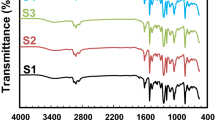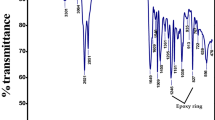Abstract
Polyaniline (PANi) has been intensively incorporated in epoxy coatings as a conducting material. However, epoxy coatings containing PANi have poor mechanical properties. In this study, polyaniline/silica (PANi/SiO2) nanocomposites with different contents of silica were prepared via in situ chemical oxidative polymerization method. Fourier transform infrared spectroscopy (FTIR), field emission scanning electron microscopy (FESEM), and zeta potential measurements were used to examine the structure and the morphology of synthesized PANi/SiO2 nanocomposites. The thermal and electrical properties of the nanocomposite were studied by thermogravimetric analysis (TGA) and standard four-probe electrode method. It was shown that silica (SiO2) nanoparticles were covered by PANi in PANi/SiO2 nanocomposites and the electrical conductivity of nanocomposites decreased with the increase in SiO2 content. The PANi/SiO2 nanocomposite with 4.1 wt% SiO2 had a conductivity of 7.6 × 10−2 S/cm and that of PANi was 8.7 × 10−2 S/cm. Consequently, epoxy coatings containing 30 wt% PANi/SiO2 nanocomposites displayed a higher surface and volume resistance than the one containing pure PANi. In contrast, the increase in SiO2 content in PANi/SiO2 nanocomposite enhanced the mechanical properties of the epoxy coating, compared to epoxy coating containing pure PANi. The coating containing PANi/SiO2 nanocomposite with 17.2 wt% silica presented good mechanical properties (20 L/mil abrasion resistance, 100 kg cm impact strength) and admissible surface and volume resistivity (1.3 × 1011 Ω/cm2 and 6.6 × 1010 Ω cm, respectively) for antistatic coatings.









Similar content being viewed by others
References
Shi, X, Nguyen, TA, Suo, Z, Liu, Y, Avci, R, “Effect of Nanoparticles on the Anticorrosion and Mechanical Properties of Epoxy Coating.” Surf. Coat. Tech., 204 (3) 237–245 (2009)
Pourhashem, S, Vaezi, MR, Rashidi, A, Bagherzadeh, MR, “Exploring Corrosion Protection Properties of Solvent Based Epoxy-Graphene Oxide Nanocomposite Coatings on Mild Steel.” Corros. Sci., 115 78–92 (2017)
Nguyen, TD, Tran, BA, Vu, KO, Nguyen, AS, Trinh, AT, Pham, GV, To, TTX, Phan, MV, Phan, TT, “Corrosion Protection of Carbon Steel Using Hydrotalcite/Graphene Oxide Hybrid.” J. Coat. Technol. Res., 16 (2) 585–595 (2019)
Rahateka, SS, Zammarano, M, Matko, S, Koziol, KK, Windle, AH, Nyden, M, Kashiwagi, T, Gilman, JW, “Effect of Carbon Nanotubes and Montmorillonite on the Flammability of Epoxy Nanocomposite.” Polym. Degrad. Stab., 95 (5) 870–879 (2010)
Dorigato, A, Pegoretti, A, “Development and Thermo-Mechanical Behavior of Nanocomposite Epoxy Adhesives.” Polym. Adv. Technol., 23 (3) 660–668 (2012)
Wernik, JM, Meguid, SA, “On the Mechanical Characterization of Carbon Nanotube Reinforced Epoxy Adhesives.” Mater. Des., 59 19–32 (2014)
Iyer, G, Gorur, RS, Richert, R, Krivda, A, Schmidt, LE, “Dielectrical Properties of Epoxy Based Nanocomposites for High Voltage Insulation.” IEEE Trans. Dielect. Electr. Insul., 18 (3) 659–666 (2011)
Bell, M, Krentz, T, Nelson, JK, Schadler, L, Wu, K, Breneman, C, Zhao, S, Hillborg, H, Benicewicz, B, “Investigation of Dielectric Breakdown in Silica-Epoxy Nanocomposites Using Designed Interfaces.” J. Colloid Interface Sci., 495 130–139 (2017)
Oyharcabal, M, Olinga, T, Foulc, MP, Vigneras, V, “Polyaniline/Clay as Nanostructured Conductive Filler for Electrically Conductive Epoxy Composites. Influence of Filler Morphology, Chemical Nature of Reagents, and Curing Conditions on Composite Conductivity.” Synth. Met., 162 555–562 (2012)
Zabet, M, Moradian, S, Ranjbar, Z, Zanganeh, N, “Effect of Carbon Nanotubes on Electrical and Mechanical Properties of Multiwalled Carbon Nanotubes/Epoxy Coatings.” J. Coat. Technol. Res., 13 (1) 191–200 (2016)
Micheli, D, Vricella, A, Pastore, R, Delfini, A, Giusti, A, Albano, M, Marchetti, M, Moglie, F, Primiani, VM, “Ballistic and Electromagnetic Shielding Behaviour of Multifunctional Kevlar Fiber Reinforced Epoxy Composites Modified by Carbon Nanotubes.” Carbon, 104 141–156 (2016)
Zhu, A, Wang, H, Sun, S, Zhang, C, “The Synthesis and Antistatic, Anticorrosive Properties of Polyaniline Composite Coating.” Prog. Org. Coat., 122 270–279 (2018)
Aal, NA, El-Tantawy, F, Al-Hajry, A, Bououdina, M, “New Antistatic Charge and Electromagnetic Shielding Effectiveness from Conductive Epoxy Resin/Plasticized Carbon Black Composites.” Polym. Compos., 29 (2) 125–132 (2008)
Wu, S, Ladani, RB, Zhang, J, Bafekrpour, E, Ghorbani, K, Mouritz, AP, Kinloch, AJ, Wang, CH, “Aligning Multilayer Graphene Flakes with an External Electric Field to Improve Multifunctional Properties of Epoxy Nanocomposites.” Carbon, 91 607–618 (2015)
Boumedienne, N, Faska, Y, Maaroufi, A, Pinto, G, Vicente, L, Benavente, R, “Thermo-Structural Analysis and Electrical Conductivity Behavior Of Epoxy/Metals Composites.” J. Phys. Chem. Solids, 104 185–191 (2017)
Jang, J, Bae, J, Lee, K, “Synthesis and Characterization of Polyaniline Nanorods as Curing Agent and Nanofiller for Epoxy Matrix Composite.” Polymer, 46 3677–3684 (2005)
Tsotra, P, Friedrich, K, “Electrical and Dielectric Properties of Epoxy Resin/Polyaniline-DBSA Blends.” J. Mater. Sci., 40 4415–4417 (2005)
Imani, A, Arabi, M, Farzi, G, “Effect of In Situ Oxidative Preparation on Electrical Properties of Epoxy/PANi/MWCNTs Nanocomposites.” J. Mater. Sci. Mater. Electron., 27 10364–10370 (2016)
Tsotra, P, Friedrich, K, “Thermal, Mechanical, and Electrical Properties of Epoxy Resin/Polyaniline-Dodecylbenzenesulfonic Acid Blends.” Synth. Met., 143 237–242 (2004)
Gu, H, Tadakamalla, S, Huang, Y, Colorado, HA, Luo, Z, Haldolaarachchige, N, Young, DP, Wei, S, Guo, Z, “Polyaniline Stabilized Magnetite Nanoparticle Reinforced Epoxy Nanocomposites.” ACS Appl. Mater. Interfaces, 4 5613–5624 (2012)
Samad, UA, Alam, MA, Chafidz, A, Al-Zahrani, SM, Alharthi, NH, “Enhancing Mechanical Properties of Epoxy/Polyaniline Coating with Addition of ZnO Nanoparticles: Nanoindentation Characterization.” Prog. Org. Coat., 119 109–115 (2018)
Nakamura, Y, Yamaguchi, M, Okubo, M, Matsumoto, T, “Effects of Particles Size on Mechanical and Impact Properties of Epoxy Resin Filled Spherical Silica.” J. Appl. Polym., 45 (7) 1281–1289 (1992)
Chen, C, Justice, RS, Schaefer, DW, Baur, JW, “Highly Dispersed Nanosilica-Epoxy Resins with Enhanced Mechanical Properties.” Polymer, 49 (17) 3805–3815 (2008)
Rao, KS, El-Hami, K, Kodaki, T, Matsushige, K, Makino, K, “A Novel Method for Synthesis of Silica Nanoparticles.” J. Colloid Interface Sci., 289 125–131 (2005)
Bousse, L, Mostarshed, S, Shoot, BVD, de Rooij, NF, Gimmel, P, Gopel, W, “Zeta Potential Measurement of Ta2O5 and SiO2 Thin Films.” J. Colloid Interface Sci., 147 (1) 22–32 (1991)
Liu, P, Liu, W, Xue, Q, “In Situ Chemical Oxidative Graft Polymerization of Aniline from Silica Nanoparticles.” Mater. Chem. Phys., 87 109–113 (2004)
Babazadeh, M, Zalloi, F, Olad, A, “Fabrication of Conductive Polyaniline Nanocomposites Based on Silica Nanoparticles via In Situ Chemical Oxidative Polymerization Technique.” Synth. React. Inorg. Met. Org. Nano-Met. Chem., 45 86–91 (2015)
Kang, ET, Neoh, KG, Tan, KL, “Polyaniline: A Polymer with Many Interesting Intrinsic Redox States.” Prog. Polym. Sci., 23 277–324 (1998)
Liu, BT, Syu, JR, Wang, DH, “Conductive Polyurethane Composites Containing Polyaniline-Coated Nano-silica.” J. Colloid Interface Sci., 393 138–142 (2013)
Gonzalez, M, Soares, B, Magioli, M, Marins, JA, Rieumont, J, “Facile Method for Synthesis of Polyaniline/Silica Hybrid Composites by Simultaneous Sol–Gel Process and “In Situ” Polymerization of Aniline.” J. Sol-Gel Sci. Technol., 63 373–381 (2012)
Huang, J, “Syntheses and Applications of Conducting Polymer Polyaniline Nanofibers.” Pure Appl. Chem., 78 (1) 15–27 (2006)
Ferchichi, K, Hbaieb, S, Amdouni, N, Pralong, V, Chevalier, Y, “Structural and Electrochemical Characterization of Polyaniline/LiCoO2 Nanocomposites Prepared via a Pickering Emulsion.” J. Solid State Electrochem., 17 1435–1447 (2013)
Wu, Z, Xiang, H, Kim, T, Chun, MS, Lee, K, “Surface Properties of Submicrometer Silica Spheres Modified with Aminopropyltriethoxysilane and Phenyltriethoxysilane.” J. Colloid Interface Sci., 304 119–124 (2006)
Acknowledgments
The authors acknowledge the support of Vietnam Academy of Science and Technology for funding of this research under Grant No. DLTE00.05/18-19.
Author information
Authors and Affiliations
Corresponding author
Additional information
Publisher's Note
Springer Nature remains neutral with regard to jurisdictional claims in published maps and institutional affiliations.
Rights and permissions
About this article
Cite this article
Nguyen, A.S., Nguyen, T.D., Thai, T.T. et al. Synthesis of conducting PANi/SiO2 nanocomposites and their effect on electrical and mechanical properties of antistatic waterborne epoxy coating. J Coat Technol Res 17, 361–370 (2020). https://doi.org/10.1007/s11998-019-00279-2
Published:
Issue Date:
DOI: https://doi.org/10.1007/s11998-019-00279-2




